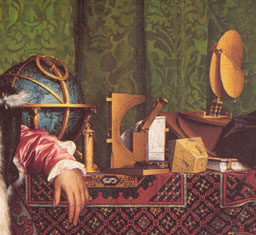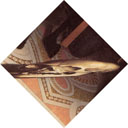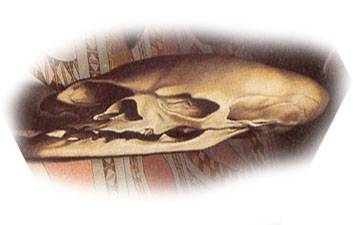|
Lisa Jardin
Hans Holbein’s almost lifesize painting now known as The Ambassadors hangs in the National Gallery in London. It was painted by the German artist during the spring of 1533 for Jean de Dinteville, resident Ambassador of the King of France, François I, at the Court of King Henry VIII in London. Jean de Dinteville had only recently taken up the post, in early February of that year. He replaced the previous ambassador shortly after Henry’s secret marriage to Anne Boleyn, while Henry was still notionally seeking the approval of the Pope for his divorce from his previous Queen, Catherine of Aragon. The double portrait shows Jean de Dinteville with his friend, the French envoy Georges de Selve, who visited England, briefly, on secret ambassadorial business from the French King in April‑May 1533. The painting left England when de Dinteville returned to France in November 1533, and hung for many years in his chateau at Polisy, next to an allegorical painting (also specially commissioned) of de Dinteville and his brother François, Bishop of Auxerre, who was the French King’s Ambassador to Rome during the same period. Some of the issues associated with Jean de Dinteville’s ambassadorial mission in England are precisely figured in the painting in the conjunctions of objects painted on the lower shelf of the piece of furniture on which he leans. The foreshortened, uncased lute (its discarded case lies under the table on de Dinteville’s side) with its prominently broken string is still recognizably an emblem of broken harmony, or discord. Beneath its neck lies an open hymn‑book. The book is Johann Walther’s Wittenberg edition of Lutheran hymns, in which we can clearly read the opening verse in German of Luther’s ‘Come Holy Ghost’ (‘Kom Heiliger Geyst’) on the left, and ‘Man wilt thou live blessedly’ (Mensch wiltu leben seliglich’), with the music for tenor voice. The discord symbolized by the broken lute‑string is specified by the hymn‑book to be that between the Catholic and Lutheran churches (but also between the Pope’s party and that of the Lutheran‑sympathizing Anne Boleyn). Since Jean de Dinteville and his brother were actively engaged in brokering a political agreement between the Pope and Henry, in spite of Anne Boleyn’s known Lutheran Church sympathies, and in spite of the fact that by remarrying in advance of papal consent to his divorce from Catherine of Aragon Henry risked excommunication, this seems an appropriate theme for de Dinteville’s painting. The collection of harmonizing flutes under the hymn‑book lie alongside the lute, ready for use (should the mission have proved successful), but currently in their case.
On the left of this lower shelf is a terrestrial globe, so meticulously represented that it can be readily identified as Behaim’s, and a German merchant‑accounting book, held open by a surveyor’s square. A pair of compasses spans the table between globe and lute. The markings on this globe continue the theme of discord—this time territorial. The globe is tipped away from the viewer, so that the names on it (for instance, ‘AFRICA’) are upside‑down. However, Significant names have been written so that the viewer reads them right way up. Thus all names within Europe are marked legibly, and a number of further names important to de Dinteville’s own diplomatic career have been added (including that of de Dinteville’s home town of Polisy). Strikingly, over in the new world, ‘Brazil’ (‘Brisilici R.’) is written legibly and right way up for the viewer, and complements the clearly drawn ‘Line of division between Spain and Portugal’ (‘Linea Divisionis Castellanorum et Portugallenum’)—the line agreed under the 1494 Treaty of Tordesillas, which designated all new‑world territory to the east of it as belonging to Portugal, all that to the west as belonging to Spain. It was this line which under the Treaty of Saragossa of 1529 had been extended round to the other side of the globe (thus the side not visible if the viewer is to be able to see Europe and the Mediterranean), to decide the ownership of the spice islands, the Moluccas. The globe, with its demarcation line, represents visually the contemporary contest between the major European powers for ownership of commercially valuable territories ‑ Brazil to the west, and the unseen Moluccas to the east. As the hymn‑book sits alongside the lute, so, in front of the Nuremberg globe, lies the German astronomer Peter Apian’s arithmetic book, A New and Well‑Grounded Instruction in All Merchant’s Arithmetic. Books for reckoning up profit and loss and maps recording routes and trading rights belonged together as part of the expanding markets of the first half of the sixteenth century. Peter Apian’s was particularly resonant as a symbol of commercial learning, since his geometrical, astronomical and navigational publications were a crucial part of the innovative work in these areas which was expanding commercial possibilities around the globe. Martin Behaim’s globe, which had originally been commissioned by Nuremberg merchants, to try to open up trade routes that would break the Portuguese cartel dominating the spice trade, and which had played such a vital part in the voyages of discovery, stands both for international navigation and for international trade. On the upper shelf of the table between de Dinteville and de Selve is a celestial globe, a collection of scientific, astronomical instruments and a closed book. This globe, too, can be identified. It was made by Johann Schöner in 1532/3—the most up‑to‑date celestial globe available, by the man whose innovation in commercially directed science was to extend to his key role as facilitator for the publication of Copernicus’ On the Revolutions of the Celestial Spheres in 1543. Instrument‑maker, scientific publisher and Lutheran, Schöner, like Apian, straddled the worlds of science, religious politics and commerce. At the visual centre of Holbein’s The Ambassadors, an array of instruments and apparatus for mastering the heavens and gaining precise knowledge of time and place, for navigating the globe and mapping and recording geographical findings claim the viewer’s attention. The arrangement of instruments lies directly between the eye‑level of the two sitters, and their carefully posed, rested hands (de Dinteville’s left, de Selve’s right). These scientific instruments appear in an earlier Holbein portrait of the German merchant and astronomer‑in‑residence to Henry VIII Nicolaus Kratzer. Recent X‑rays of the painting taken during cleaning show that this section was inserted as a pre‑existing composition by the artist. It was therefore in all likelihood painted five years earlier, as a still‑life study while Holbein was painting his portrait of Kratzer. The cylinder dial is set for the equinox, and the celestial globe is very roughly set for the autumnal equinox, with the sign of Scorpio rising. The future Queen Elizabeth was born on 7 September 1533, a few days from the equinox. On the pillar dial immediately alongside the globe Holbein has painted the shadows so that the date shown is Good Friday, 11 April 1533, the date on which Anne Boleyn was accorded full royal honours.
The Ottoman rug which covers the upper shelf of the table in Holbein’s The Ambassadors, and links the resting arms (and perhaps the political intrigues) of de Dinteville and de Selve, reminds us that the power to be reckoned with in the 1530s, other than the Habsburgs, was the Turks. It also reminds us what coveted items Ottoman commodities were in the circles in which Holbein and de Dinteville moved, worthy to be lovingly represented in a painting which celebrated the worldly success of the sitters. Holbein’s representation of the rug is as carefully precise as that of his globes and instruments ‑ even today it allows carpet specialists to identify it as of a particularly valuable and interesting type of early oriental carpet (known to carpet specialists as a ‘Holbein’), though few actual carpets from the period still survive. Early 1533 was a fraught period of English diplomatic activity. Anne Boleyn was pregnant, and the King was not prepared to risk the ‘boy’ being born a bastard by delaying her recognition as his legitimate wife while the Pope procrastinated. François I was meanwhile trying to persuade Henry not to go public until he had smoothed the path of divorce and remarriage with the Medici Pope, Clement VII, though he nevertheless expressed personal support for the English King. François was to have been godfather to the baby had it been a boy. Meanwhile in Rome, Jean de Dinteville’s brother François was trying discreetly to encourage the Pope to reach a decision acceptable to the English King concerning his Great Matter. On 23 May, a week before Anne’s coronation, Jean de Dinteville wrote to his brother (in a letter whose evasive phrasing clearly showed that he expected it to be intercepted and read by Henry’s agents) with a veiled warning that it might be necessary for the French to intervene directly with the Pope, since things in London were coming to a head. The official announcement that Henry’s marriage was legitimate was actually made in London that very day. At the end of his letter Jean de Dinteville added a personal comment on his own current state of mind:
This country is beginning to displease me, as I wait for the expiry of my six months’ term (which expires on 22 July). I was promised by the Grand Master that I would not have to stay longer than that. I pray to God that he will keep his promise. I have had a tertian fever which it took a long time to get rid of. Please put in a word for me with M. de Paris about my recall. I must tell you that I am the most melancholy‑vexed and tiresome ambassador that ever was.
‘If I stay here much longer I greatly fear I’ll leave my skin and bones here. I have only enjoyed one week of good health in the whole time I’ve been here,’ de Dinteville wrote a little later, still pleading for recall. The two skulls which figure prominently in Holbein’s painting seem a fair reflection of the sitter’s gloomy emotional state and his constant ill‑health while in London. In addition to the curiously represented skull which dominates the bottom of the canvas (and which can be correctly seen as a skull only if viewed from one prescribed vantage‑point below and to the left of the painting), de Dinteville sports in his hat a badge or pin in the form of a death’s head. The skull was a conventional ‘vanitas’ emblem, a humbling reminder of death even amid splendour. Georges de Selve arrived in London shortly before the public announcement of the King’s remarriage, and left before the pageantry of Anne’s coronation at the beginning of June. It is possible that his ‘secret business’ concerned development within the Lutheran Church (of which both he and de Dinteville were moderate supporters) and was part of Anglo‑French discussions of the appropriate response to the Reformation’s growing hold on the German states. De Dinteville was certainly anxious that news of de Selve’s visit should not be communicated to the French Grand Master (the French King’s most senior minister), Anne de Montmorency, who was a strong supporter of the Catholic party in France. However, the most sensitive arena of negotiation in which Georges de Selve was involved was located in Venice. The previous year, François I’s special envoy Rincòn had set out via Venice and Ragusa for Istanbul, with instructions to ask the Ottoman Sultan, Suleiman the Magnificent, to continue his expansionist wars against Charles V on the Italian front, rather than the Austrian one, in order that the French might regain Genoa and the duchy of Milan as part of the action. Throughout 1533 Rincòn and the Sultan’s own trusted envoy Yunus Beg were in Venice negotiating a future Franco‑Ottoman political and commercial partnership. De Selve shuttled between Paris and Venice carrying dispatches on the talks (in December 1533 de Selve was appointed French resident ambassador in Venice). Strategically, alliance with the one contender for imperial power round the Mediterranean offered the only possible hope of resistance to Charles V. François I confided in the Venetian Ambassador: ‘I cannot deny that I keenly desire the Turk powerful and ready for war, not for himself, because he is an infidel and we are Christians, but to undermine the Emperor’s [Charles V’s] power, to force heavy expenses upon him and to reassure all other governments against so powerful an enerny. Under these circumstances, public hostility was a cover for something approaching diplomatic cordiality behind the scenes. When François and Henry had been on the point of signing their treaty of alliance at Calais in October 1532 François had written to Jean de Dinteville’s brother (six months before Jean de Dinteville sat for his portrait in London):
To anyone who asks you about the preparations which might be taking place with a view to an understanding between the King of England and myself, you can tell them that seeing the major preparations for an invasion of the Christian territories, which the Turks are currently involved in, we want to be prepared to combine to initiate whatever is necessary as much for the good of those Christian territories, of which we are by God’s will the principal leaders, as in order not to be at the mercy of the Turkish troops.
In fact, the treaty signed between Henry and François was intended to be the first stage in the assembling of an alliance which would include Suleiman. As an early‑seventeenth‑century treatise on ambassadors points out, it is entirely acceptable for those of differing religious persuasions to sustain cordial diplomatic and commercial relations: ‘Christian Princes and Estates make no difficulties to hold their Agents and Factors with the Turkes when they haue occasion.’ The setting for The Ambassadors (identified by the pavement on which the two men stand) is the chapel in Westminster Abbey in which Henry VIII’s new Queen, Anne Boleyn, was crowned with great pomp and ceremony at the end of May or beginning of June 1533. Jean de Dinteville played a prominent part in Anne’s coronation, as the representative of the French Crown (the only major foreign power apart from Venice thus represented) in the various extravagant processions and ceremonies, and contributing lavishly to the expenses of the spectacle. Twelve of de Dinteville’s servants led the procession which took Anne to the Abbey. They wore French colours—blue velvet with yellow and blue sleeves, with white plumes in their hats. Their horses had trappings of blue sarsenet, powdered with white crosses. (In December 1533, François I reimbursed his ambassador for his personal financial outlay on this occasion with a gift Of 500 gold écus.) While support for the remarriage and coronation was in the interests of the French King, whose political ambition was to cement an alliance with Henry against Charles V, Henry’s subjects were openly hostile to this display of French magnificence at an English royal occasion. Charles V’s ambassador Chapuys reported home in his dispatches that Jean de Dinteville and his retinue, leading the coronation procession with the Archbishop of Canterbury, had been booed and insulted by the crowd along the route. Alongside Jean de Dinteville, Georges de Selve’s presence in the double portrait registers the continuing diplomatic intrigues between the competing imperial powers in and beyond Europe, and the strong connection between these and the same powers’ commercial aspirations. We do not in the end know whether the exchanges of information between de Dinteville and de Selve during the latter’s brief visit were concerned with wealth‑creation through trading agreements or with political alliance‑formation. Their private dealings are recorded in the painting as a liaison whose purpose is secret, but whose connection with power and wealth is marked by the presence of the Ottoman rug and the German artefacts, whose exquisite beauty captures the onlooker’s attention at the expense of the sitters themselves. At the centre of the painting—where we might expect a Madonna, flanked by the two diplomats as her donors or saints—is a collection of valuable scientific instruments and desirable consumer objects or belongings. And hanging over de Dinteville, revealed behind the sumptuous curtains which set off the ambassadors’ portraits, is an exquisitely crafted silver crucifix. The crucifix reminds us that the political and doctrinal might of the Catholic Church and its protector, the Holy Roman Emperor, waited just beyond the bounds of the painting, shaping contemporary events. But the crucifix, too, was an object of value in its own right—concrete evidence that the Catholic Church, also, was part of the competition for riches, spices and territorial dominion which defined the European Renaissance. Holbein’s painting captured for all time the way the French Ambassador wished to be remembered by posterity, but it also celebrated the very achievements to which we still attach value in the late twentieth century. The artist has lavished infinite care on the surfaces of desirable objects ‑ objects which are of great price, are things of beauty in themselves and are also masterpieces of technological skill. Prestige and power are represented by this accumulation of valuable goods, and by the sumptuous dress and nonchalantly self‑centred pose of the sitters.
But what is not
represented here is as important as what is. There is nothing parochial
about The Ambassadors—a painting of French aristocrats, executed in
England by a German artist, and replete with allusions to commercial
centres in Germany, Italy and Istanbul, to intellectual developments in
Nuremberg, Wittenberg and London, and to political exchanges between
France, England, Germany, Venice and Istanbul. It was the Renaissance
which opened these international and cosmopolitan horizons, the
Renaissance which kindled the desire to purchase the rare and the
beautiful as a sign of individual (or family) success. The world we
inhabit today, with its ruthless competitiveness, fierce consumerism,
restless desire for ever wider horizons, for travel, discovery and
innovation, a world hemmed in by the small‑mindedness of petty nationalism
and religious bigotry but refusing to bow to it, is a world which was made
in the Renaissance. |





